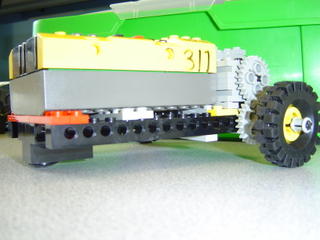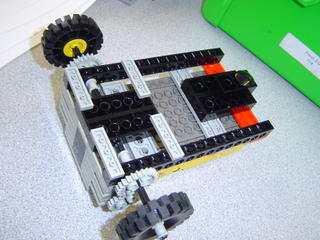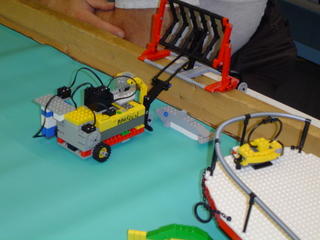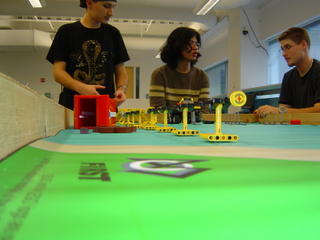Brownies & Robotics
The beautiful thing about brownies is how quickly you can make 'em. And I'm not using a mix, either. This is my mom's brownie recipe, and it is really, really good. Basically, you heat 1/3 cups of butter and 3/4 cups of sugar and 2 T of water in a saucepan, stirring, until it just begins to boil. Then take it off the heat and add 1 cup of chocolate chips and 1 t of vanilla. Add two eggs, then add 3/4 cups of flour and 1/4 t of baking soda, and stir. Then add 1 more cup of chocolate chips and 1/2 cup of chopped walnuts (if you want 'em). Bake for 30 minutes at 325 F.
But this post is not about brownies. It's about robotics.
That concert that I posted about below did not end until 1 am, and for some reason the friend I went with was just not picking up on how tired I was, so we stayed to buy CDs and chat with the singer... fun, but I didn't get home until 2, and then I had to look up the location of the robotics workshop, so I wasn't in bed until much later.
I was not a pretty sight come 8 am. To my surprise, my roommate was awake before 8 and cooking something... "I know what I'm doing awake at 8 am on a Saturday morning, but why the heck are you up?" Turns out he was on his way to North Carolina for the weekend.
 The first good thing about robotics is that the guys running the workshops are quite cute, very friendly, smart, and helpful.* And they pack a lot of information into a short period of time. Unfortunately, a lot of what we did in the workshop today was a repeat of the intro workshop at the kickoff event a couple of weeks ago, but this time I got to install Robolab on my computer and actually do the programming myself as we learned each icon, and that made the repetition bearable. Towards the end of the morning, we moved on to new stuff, and then they handed out Lego kits and plans for a simple robot - unimaginatively named "Simplebot." And we were off and building!
The first good thing about robotics is that the guys running the workshops are quite cute, very friendly, smart, and helpful.* And they pack a lot of information into a short period of time. Unfortunately, a lot of what we did in the workshop today was a repeat of the intro workshop at the kickoff event a couple of weeks ago, but this time I got to install Robolab on my computer and actually do the programming myself as we learned each icon, and that made the repetition bearable. Towards the end of the morning, we moved on to new stuff, and then they handed out Lego kits and plans for a simple robot - unimaginatively named "Simplebot." And we were off and building!

My kit was missing a lot of pieces, so I had to modify Simplebot, which was an interesting challenge and, I think, actually helped me learn more about the contents of the kit than I would have if I'd just followed the instructions as written.
After lunch, a new friend and I wrote a short program which made Simplebot move forward for a given period of time, turn for a given period of time, and then repeat this four times. We were trying to move in a square but the turn was far more than 90 degrees.

It was so exciting to upload our program to the RCX (the robot's "brain") and then watch our robot follow our program. I was practically jumping up and down. It was also hilarious, because we were powering Simplebot from an AC adapter, which was sort of a tether and kept getting tangled up under Simplebot's wheels. Once we started holding up the power cord away from the table, the tangling problem disappeared. Then we revised our program so that Simplebot would move forward for a random amount of time (up to 5 seconds), then turn for a random amount of time, and then repeat this sequence several more times. The unintended effect of this program was that Simplebot would aim for the nearest inanimate object, wall, or edge of the table, hit it, turn, and aim for the next. Or at least, that's what you would have thought to watch it spin towards feet, table legs, and anything else that could cause it's destruction.
 The first two pictures are of Simplebot, first a side view and then a peek underneath to see more of its construction. The next couple of pictures give you an idea of what the playing field looks like. Basically, the theme is the oceans, and the playing field consists of a number of challenges worth various amounts of points. The robots on the playing field are not mine. The first of these pictures shows a cage where a shark (you can see it on the table next to the robot) is kept. The cage balances between two teams' playing fields. The challenge is to be the first team whose robot bumps a lever and releases the shark out of the cage onto their own playing field. The second picture was taken from the level of the playing field. The little brown blocks are supposedly cargo spilled from the red shipping boxcar. The challenge is to move them to the base, for five points each. They also serve as bonus points - every time a team member has to touch the robot (when it is not in base), one block is removed from the playing field. Those left on the field add two points each to the score, or five if they've been moved to base. The yellow and grey thing is a pipeline. You can't see it clearly, but the challenge is to "fix" a broken piece of pipeline by moving it into position, then toggle the flags at the end (by hand). And these are only a few of many more challenges!
The first two pictures are of Simplebot, first a side view and then a peek underneath to see more of its construction. The next couple of pictures give you an idea of what the playing field looks like. Basically, the theme is the oceans, and the playing field consists of a number of challenges worth various amounts of points. The robots on the playing field are not mine. The first of these pictures shows a cage where a shark (you can see it on the table next to the robot) is kept. The cage balances between two teams' playing fields. The challenge is to be the first team whose robot bumps a lever and releases the shark out of the cage onto their own playing field. The second picture was taken from the level of the playing field. The little brown blocks are supposedly cargo spilled from the red shipping boxcar. The challenge is to move them to the base, for five points each. They also serve as bonus points - every time a team member has to touch the robot (when it is not in base), one block is removed from the playing field. Those left on the field add two points each to the score, or five if they've been moved to base. The yellow and grey thing is a pipeline. You can't see it clearly, but the challenge is to "fix" a broken piece of pipeline by moving it into position, then toggle the flags at the end (by hand). And these are only a few of many more challenges!
*Yes, I am still boy-crazy. Get used to it.
But this post is not about brownies. It's about robotics.
That concert that I posted about below did not end until 1 am, and for some reason the friend I went with was just not picking up on how tired I was, so we stayed to buy CDs and chat with the singer... fun, but I didn't get home until 2, and then I had to look up the location of the robotics workshop, so I wasn't in bed until much later.
I was not a pretty sight come 8 am. To my surprise, my roommate was awake before 8 and cooking something... "I know what I'm doing awake at 8 am on a Saturday morning, but why the heck are you up?" Turns out he was on his way to North Carolina for the weekend.
 The first good thing about robotics is that the guys running the workshops are quite cute, very friendly, smart, and helpful.* And they pack a lot of information into a short period of time. Unfortunately, a lot of what we did in the workshop today was a repeat of the intro workshop at the kickoff event a couple of weeks ago, but this time I got to install Robolab on my computer and actually do the programming myself as we learned each icon, and that made the repetition bearable. Towards the end of the morning, we moved on to new stuff, and then they handed out Lego kits and plans for a simple robot - unimaginatively named "Simplebot." And we were off and building!
The first good thing about robotics is that the guys running the workshops are quite cute, very friendly, smart, and helpful.* And they pack a lot of information into a short period of time. Unfortunately, a lot of what we did in the workshop today was a repeat of the intro workshop at the kickoff event a couple of weeks ago, but this time I got to install Robolab on my computer and actually do the programming myself as we learned each icon, and that made the repetition bearable. Towards the end of the morning, we moved on to new stuff, and then they handed out Lego kits and plans for a simple robot - unimaginatively named "Simplebot." And we were off and building!
My kit was missing a lot of pieces, so I had to modify Simplebot, which was an interesting challenge and, I think, actually helped me learn more about the contents of the kit than I would have if I'd just followed the instructions as written.
After lunch, a new friend and I wrote a short program which made Simplebot move forward for a given period of time, turn for a given period of time, and then repeat this four times. We were trying to move in a square but the turn was far more than 90 degrees.

It was so exciting to upload our program to the RCX (the robot's "brain") and then watch our robot follow our program. I was practically jumping up and down. It was also hilarious, because we were powering Simplebot from an AC adapter, which was sort of a tether and kept getting tangled up under Simplebot's wheels. Once we started holding up the power cord away from the table, the tangling problem disappeared. Then we revised our program so that Simplebot would move forward for a random amount of time (up to 5 seconds), then turn for a random amount of time, and then repeat this sequence several more times. The unintended effect of this program was that Simplebot would aim for the nearest inanimate object, wall, or edge of the table, hit it, turn, and aim for the next. Or at least, that's what you would have thought to watch it spin towards feet, table legs, and anything else that could cause it's destruction.
 The first two pictures are of Simplebot, first a side view and then a peek underneath to see more of its construction. The next couple of pictures give you an idea of what the playing field looks like. Basically, the theme is the oceans, and the playing field consists of a number of challenges worth various amounts of points. The robots on the playing field are not mine. The first of these pictures shows a cage where a shark (you can see it on the table next to the robot) is kept. The cage balances between two teams' playing fields. The challenge is to be the first team whose robot bumps a lever and releases the shark out of the cage onto their own playing field. The second picture was taken from the level of the playing field. The little brown blocks are supposedly cargo spilled from the red shipping boxcar. The challenge is to move them to the base, for five points each. They also serve as bonus points - every time a team member has to touch the robot (when it is not in base), one block is removed from the playing field. Those left on the field add two points each to the score, or five if they've been moved to base. The yellow and grey thing is a pipeline. You can't see it clearly, but the challenge is to "fix" a broken piece of pipeline by moving it into position, then toggle the flags at the end (by hand). And these are only a few of many more challenges!
The first two pictures are of Simplebot, first a side view and then a peek underneath to see more of its construction. The next couple of pictures give you an idea of what the playing field looks like. Basically, the theme is the oceans, and the playing field consists of a number of challenges worth various amounts of points. The robots on the playing field are not mine. The first of these pictures shows a cage where a shark (you can see it on the table next to the robot) is kept. The cage balances between two teams' playing fields. The challenge is to be the first team whose robot bumps a lever and releases the shark out of the cage onto their own playing field. The second picture was taken from the level of the playing field. The little brown blocks are supposedly cargo spilled from the red shipping boxcar. The challenge is to move them to the base, for five points each. They also serve as bonus points - every time a team member has to touch the robot (when it is not in base), one block is removed from the playing field. Those left on the field add two points each to the score, or five if they've been moved to base. The yellow and grey thing is a pipeline. You can't see it clearly, but the challenge is to "fix" a broken piece of pipeline by moving it into position, then toggle the flags at the end (by hand). And these are only a few of many more challenges!*Yes, I am still boy-crazy. Get used to it.






0 Comments:
Post a Comment
<< Home